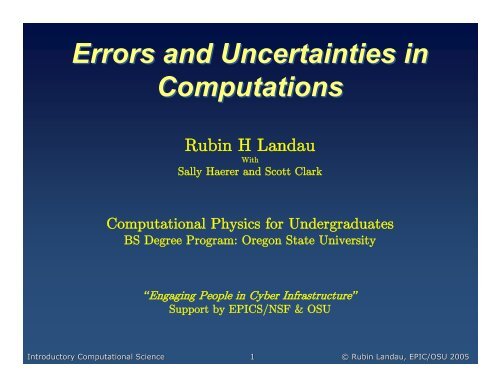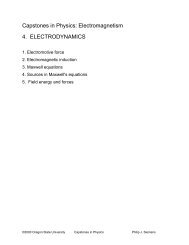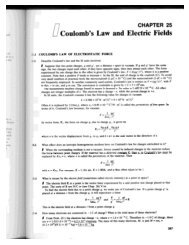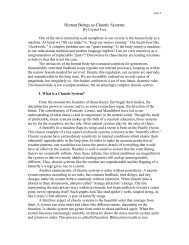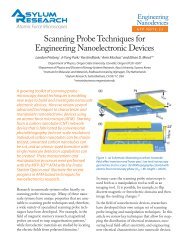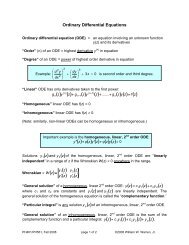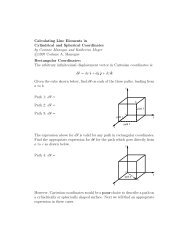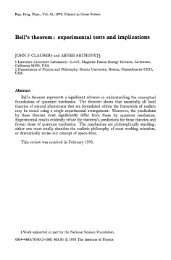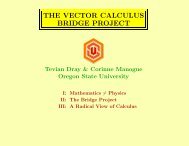Errors and Uncertainties in Computations Errors and Uncertainties ...
Errors and Uncertainties in Computations Errors and Uncertainties ...
Errors and Uncertainties in Computations Errors and Uncertainties ...
You also want an ePaper? Increase the reach of your titles
YUMPU automatically turns print PDFs into web optimized ePapers that Google loves.
<strong>Errors</strong> <strong>and</strong> <strong>Uncerta<strong>in</strong>ties</strong> <strong>in</strong><br />
<strong>Computations</strong><br />
Rub<strong>in</strong> H L<strong>and</strong>au<br />
With<br />
Sally Haerer <strong>and</strong> Scott Clark<br />
Computational Physics for Undergraduates<br />
BS Degree Program: Oregon State University<br />
“Engag<strong>in</strong>g People <strong>in</strong> Cyber Infrastructure”<br />
Support by EPICS/NSF & OSU<br />
Introductory Computational Science 1<br />
© Rub<strong>in</strong> L<strong>and</strong>au, EPIC/OSU 2005
Problem: Life + <strong>Errors</strong> (<strong>Uncerta<strong>in</strong>ties</strong>)<br />
Always part of computation<br />
F<strong>in</strong>ite precision uncerta<strong>in</strong>ties = “errors”<br />
Don't be afraid; Don't play with garbage<br />
<strong>Errors</strong> accumulate with steps U i<br />
start → U1 → U2 → ...→ Un<br />
→ end<br />
(1)<br />
• p = probability U i correct<br />
• P = p n = probability n steps correct<br />
• n= 1000, p = 0.9993 P = 1/2<br />
• (whoops!)<br />
Introductory Computational Science 2<br />
© Rub<strong>in</strong> L<strong>and</strong>au, EPIC/OSU 2005
Theory: Types of <strong>Errors</strong> (4 plagues)<br />
1. Blunders: typos, wrong program, wrong data, …<br />
2. R<strong>and</strong>om errors: electronic fluctuations, cosmic rays, …<br />
– rare, but if 10 8 steps?<br />
– can't control<br />
– repeat calculation<br />
3. Approximation errors, algorithm, approx math:<br />
e −x =<br />
∞X<br />
n=0<br />
(−x) n<br />
n!<br />
'<br />
NX<br />
n=0<br />
(−x) n<br />
n!<br />
= e −x + E(x, N)<br />
(2)<br />
• decreases as N <strong>in</strong>creases<br />
• vanishes as N <br />
4. Round-Off <strong>Errors</strong> (cont)<br />
Introductory Computational Science 3<br />
© Rub<strong>in</strong> L<strong>and</strong>au, EPIC/OSU 2005
<strong>Errors</strong> (cont)--<br />
Roundoff errors:<br />
Because: numbers via f<strong>in</strong>ite # bits<br />
≈ uncerta<strong>in</strong>ties <strong>in</strong> measurement<br />
Some numbers represent exact (2 n )<br />
Accumulates with steps unstable<br />
garbage: RO ≈ result:<br />
2 ¡ 1<br />
3<br />
¢<br />
−<br />
2<br />
3<br />
=0.66666 − 0.66667 = −0.00001 6=0<br />
(3)<br />
Significant figures<br />
• a = 11223344556677889900<br />
= 1.12233445566778899 * 10 19<br />
(4)<br />
• exponent: stored separately<br />
small full precision<br />
Most significant part: 1.12233<br />
Least significant part: 44556677<br />
• error prone<br />
Introductory Computational Science 4<br />
© Rub<strong>in</strong> L<strong>and</strong>au, EPIC/OSU 2005
Disaster Model: Subtractive Cancellation<br />
If you subtract two large numbers <strong>and</strong> end up with a small<br />
result, there will be less significance <strong>in</strong> the small result<br />
a = b − c ⇒ a c = b c − c c<br />
(5)<br />
a c = b(1 + ² b ) − c(1 + ² c )<br />
(6)<br />
e −x = 1 −x + x2<br />
2 − x3<br />
6 +···= 1 −100 +5000 +··· (9)<br />
⇒<br />
a c<br />
a = 1 + ² b<br />
b<br />
a − c a ² c<br />
(7)<br />
' 1 − b a (² b − ² c ) → ∞<br />
(8)<br />
HW: Cancellation <strong>in</strong> power series, x = 100:<br />
Introductory Computational Science 5<br />
© Rub<strong>in</strong> L<strong>and</strong>au, EPIC/OSU 2005
Model for Multiplicative <strong>Errors</strong><br />
• Propagation of error <strong>in</strong>multiplication<br />
a = b × c ⇒ a c = b c × c c ,<br />
⇒<br />
a c<br />
a =(1 + ² b)(1 + ² c ) ' 1 + ² b + ² c<br />
(10)<br />
(11)<br />
• How add errors? |² b | + |² c |, |² b | − |² c |?<br />
• Algorithm Model: N steps r<strong>and</strong>om walk (Chap.5)<br />
² ro ≈ √ N² m<br />
N<br />
• Each step ' mach<strong>in</strong>e precision<br />
If non r<strong>and</strong>om: ² ' N² m , N!² m<br />
E.G.: several hour calculation, 10 10 Flops<br />
⇒ ² ' 10 7 ² m<br />
S<strong>in</strong>gles: ² m ' 10 −7<br />
⇒ ² ' 1 (whoops!)<br />
Introductory Computational Science 6<br />
© Rub<strong>in</strong> L<strong>and</strong>au, EPIC/OSU 2005<br />
R<br />
1<br />
4<br />
2 3
Experiment: Determ<strong>in</strong>e <strong>Errors</strong><br />
1. Basic algorithm questions:<br />
a) does it converge?<br />
b) if not, quit<br />
c) how precise are converged results?<br />
2. Converged correct<br />
3. How $$ (time consum<strong>in</strong>g) ?<br />
Introductory Computational Science 7<br />
© Rub<strong>in</strong> L<strong>and</strong>au, EPIC/OSU 2005
Experiment: Expected Behavior<br />
• ² apprx<br />
= approximation error = A ns exact -A<br />
ns algorithm<br />
• Algorithmic errordecreases rapidly<br />
² aprx ' α → 0, (N → ∞),<br />
N<br />
β<br />
(12)<br />
• Round oFF error <strong>in</strong>creases slowly<br />
² RO ' √ N ² m<br />
(13)<br />
• Want m<strong>in</strong>imum of sum<br />
² tot = ² approx + ² RO ,<br />
α<br />
'<br />
N + √ N² β<br />
m<br />
(14)<br />
• Want N small ⇒ faster, accurate<br />
Introductory Computational Science 8<br />
© Rub<strong>in</strong> L<strong>and</strong>au, EPIC/OSU 2005
Experimental Approach<br />
Determ<strong>in</strong>e & via applied math<br />
(see text)<br />
10 -1<br />
<br />
<br />
M<strong>in</strong> via comparison to known<br />
answer<br />
• test (similar) problem<br />
If N looks good, assume 2N exact:<br />
A(N) ≈ A + α<br />
N β + RO<br />
² tot = A(N) − A(2N) ≈ α<br />
N β<br />
Plot log 10 () vs log 10 (N)<br />
• ord<strong>in</strong>ate = # decimal places precision<br />
• slope = <br />
|error|<br />
10 -3<br />
10 -5<br />
10 -7<br />
10 -9<br />
Gaussian<br />
Simpson<br />
trapezoid<br />
10 100<br />
N<br />
Look & underst<strong>and</strong>!<br />
converge diverge<br />
Introductory Computational Science 9<br />
© Rub<strong>in</strong> L<strong>and</strong>au, EPIC/OSU 2005
Time for Exercises<br />
<strong>in</strong> Lab<br />
Introductory Computational Science 10<br />
© Rub<strong>in</strong> L<strong>and</strong>au, EPIC/OSU 2005
Exercise: Subtractive Cancellation<br />
1. Equivalent solutions to<br />
ax 2 + bx + c =0<br />
x 1,2 = −b ± √ b 2 − 4ac<br />
, x 0 1,2 =<br />
2a<br />
−2c<br />
b ± √ b 2 − 4ac .<br />
Subtractive cancellation if 4ac
Subtractive Exercise (cont)<br />
2. Three equivalent (math) sums:<br />
S (1)<br />
N<br />
=<br />
S (2)<br />
N<br />
=<br />
S (3)<br />
N<br />
=<br />
2NX<br />
n=1<br />
NX<br />
n=1<br />
NX<br />
n=1<br />
(−1) n<br />
2n<br />
2n +1 −<br />
n<br />
n +1 . (1)<br />
1<br />
2n(2n +1)<br />
N X<br />
n=1<br />
2n − 1<br />
2n<br />
(even & odd), (2)<br />
(partial sums). (3)<br />
Write program to calculate S(1), S(2), S(3) 1 N 100<br />
Assume S(3) is exact<br />
Log-log plot relative error: log 10 | S(1) N<br />
−S(3) N<br />
| vs log 10<br />
(N)<br />
Get expected straight l<strong>in</strong>e?<br />
S (3)<br />
N<br />
Introductory Computational Science Lab 2<br />
© Rub<strong>in</strong> L<strong>and</strong>au, EPIC/OSU 2005
Exercise: error <strong>in</strong> e -x<br />
(cont)<br />
3. Mathematical def<strong>in</strong>ition versus algorithm<br />
e −x =1− x + x2<br />
2! − x3<br />
3! + ··· ' N X<br />
n=0<br />
(−x) n<br />
n!<br />
(1)<br />
a. Exam<strong>in</strong>e cancellation of terms for x ≈ 10<br />
b. Convergence terms decrease<br />
new = (n+1)/x old n+1 ≈ x<br />
c. Demo: near-perfect cancellation here?<br />
d. exp(-x) = 1/exp(x) better, yet still RO<br />
e. Plot error vs N for 1 x 100 (see easyPtPlot.java.)<br />
Introductory Computational Science Lab 5<br />
© Rub<strong>in</strong> L<strong>and</strong>au, EPIC/OSU 2005


